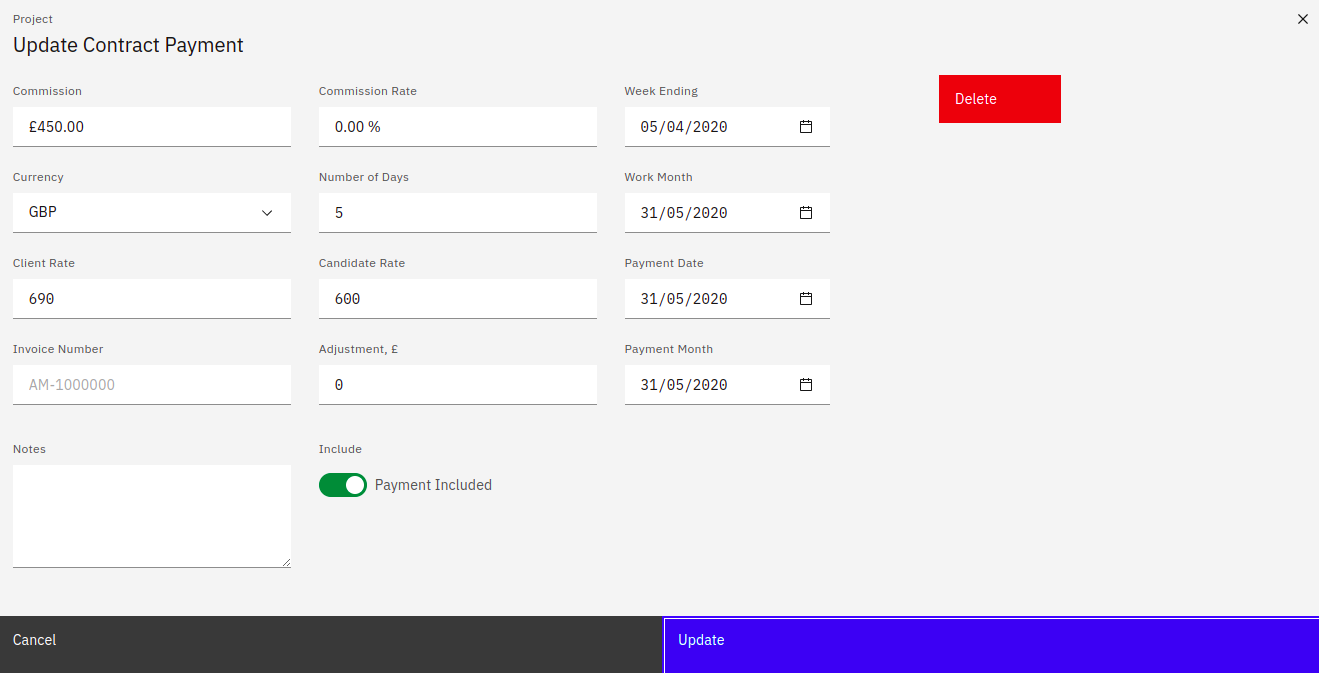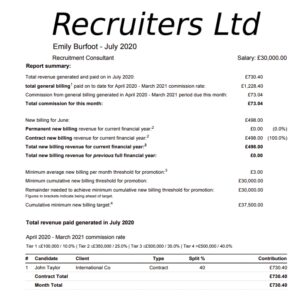For teams of recruiters keeping track of commissions is a laborious process often done with (Excel) worksheets and, hence, prone to errors. The main problem is the complexity of keeping track of the different arrangements per consultant and per specific project, and at the same time accounting for changes over time – for this data is generally not static. Worksheets are an easy solution at first, but that is a manual process and it is far too easy to make mistakes in a worksheet without realising it. Another major issue is that project billing and time sheets, core data systems with candidate data, the invoicing system and other pieces of data are often held across multiple systems. This multitude of systems poses a particular challenge for managers to effectively keep track of the business. Hence, we have built a simple web based tool, The Payroll Management Tool for recruiters, which:
- calculates commission business generated per consultant per project;
- details total commission to be paid to each consultant;
- handles one-off permanent placements and rolling contractor placements;
- stores consultant salaries and other relevant HR data;
- ensures accurate monthly payroll;
- allows flexible consultant salary, promotion and commissions structures;
- provides easy data entry of project details and payments for both permanent and contractor payments;
- can import project details and payments from various systems already used by many recruiters;
- produces different reports, e.g. payroll, commission sheets per consultant, business generated by different teams etc;
- flags up missing data;
- holds an up-to-date view of all of the work of the company.
Intro
Over the last two years we have worked on a tool (summary here) that connects many of the existing solutions already used by recruiters. It creates a single source of truth for all the project and commission data, then generates various reports on a project or consultant level. The centrepiece of the work was to ensure the system was flexible enough to accommodate different accounting rules for the commission calculations and accommodate changes over time which is rarely available from other competitors.
The tool is ideal for small and medium sized teams who want to automate and streamline commission management. It also helps reduce errors and helps with data quality in the organisation by flagging for instance missing pieces of data or by making sure data cannot easily be duplicated resulting in costly errors.
The system is web-based and accessible through any desktop browser. It stores data about clients, candidates, projects, consultants and project payments in a database that can be stored either locally or in the cloud. It accommodates both permanent and contract positions. The tool generates monthly commission sheets for the individual consultants and aggregate reports for the managers. It can integrate with existing tools popular with HR professionals like Influence, JobAdder and Invoxy. The system holds information related to project billing from a recruiter perspective. Hence, it can model consultant data like job title, salary, remuneration structures, promotion targets, business generated over various years and across various sectors. It also models basic client and candidate information needed for tracking projects across systems. For instance, one of the advantages of using it is having consistent project IDs between systems, which ensures that it is always possible to link different systems.
Integrations
Two types of data integrations are possible:
- Data can be uploaded as a CSV file: this is a quick and easy solution. For example, it is a great option for uploading Influence project data at regular intervals, e.g. weekly, monthly and so on..
- Direct API integration: the system can be configured to directly access data from various systems. For example we are building a direct TimeSheet Portal integration allowing customers to push and pull timesheet data automatically.
Full list of possible integrations:
- Influence Recruitment Software
- Invoxy for timesheet data from contractors
- Timesheet Portal again for timesheet management
- JobAdder for recruitment
By bringing together information from all these tools the system allows our customers to maintain a consistent view of their data across multiple systems. A typical use case is making sure that candidate names and invoice numbers match between the recruitment software and timesheets which are used to generate invoices.
Data Entry
Another advantage of the system is that it helps consultants and managers improve their productivity and data quality while using the same tools as before, i.e. there is no need to change existing systems and processes. Project data, like client, candidate and commission splits can be easily imported from, say, Influence through a single weekly or monthly file upload. Unfortunately, many tools do not enforce any rules on the entered data. For example, client name and address could be simple free-text fields. That means that the same client could have multiple spellings, making proper reporting a nightmare. Our system checks the uploaded data every time against existing entries and flag up duplicates, obvious errors. Sometimes it is just faster to enter the data manually. Here is an example of a data-entry form for a single project.
On the left panel, basic project fields are shown, e.g. client, candidate, invoice and PO numbers (if relevant), starting date, etc. On the right-hand side we have the commission splits for all consultants who work on the project. The splits could change over time; hence, each entry has a start and end date and all commission calculations respect these dates. Below the commission splits we display the payments. Permanent positions typically require only one payment but contracts are billed monthly and this can go on for more than a year.For each contract payment, the payment information can be entered/edited manually providing lots of flexibility when it comes to introducing changes over time:
Each payment is timestamped for when the contractor worked (Week Ending, Work Month fields) and when the commission payment is actually due (Payment Date and Payment Month fields)
Reporting
Once you have the data in, the next task is to aggregate and report on them. The core tool functionality can be extended to match your requirements. For instance, we can implement custom rules for commission calculations and design custom reports in Excel that match existing ones used by the business. This is an example of a web report displaying the revenue generated a by a single consultant in April 2022:
The full report can be downloaded as a PDF file. These commission sheets are completely customisable and can display billing targets, various yearly cumulative totals etc. An example is given below.
Company managers often want a downloadable Excel report for offline analysis. Once more, we offer customised Excel reports, e.g. monthly payroll report, project summary report, etc.
Conclusion
Our solution is a “digital transformation” project packaged as a customisable product. The system is available either as a managed solution hosted in the cloud in a geographic region of your choice or it can be deployed on premise and made available via an internal network.








